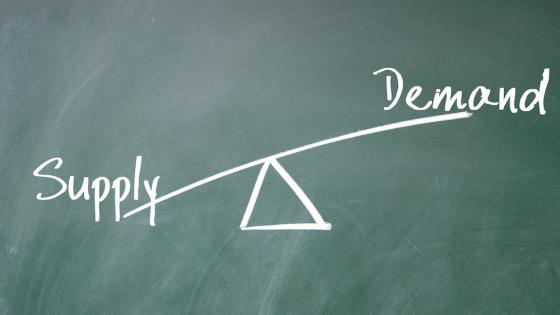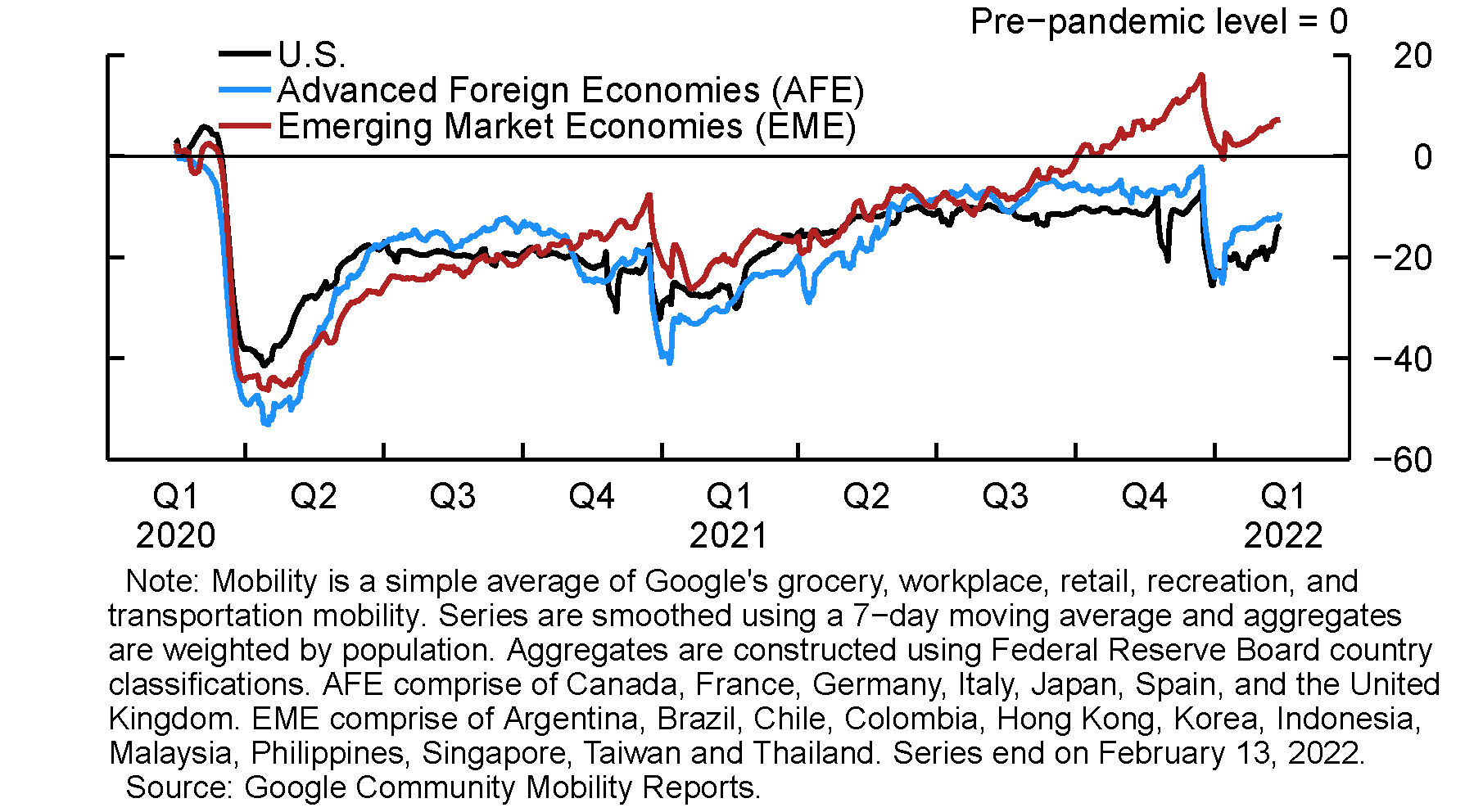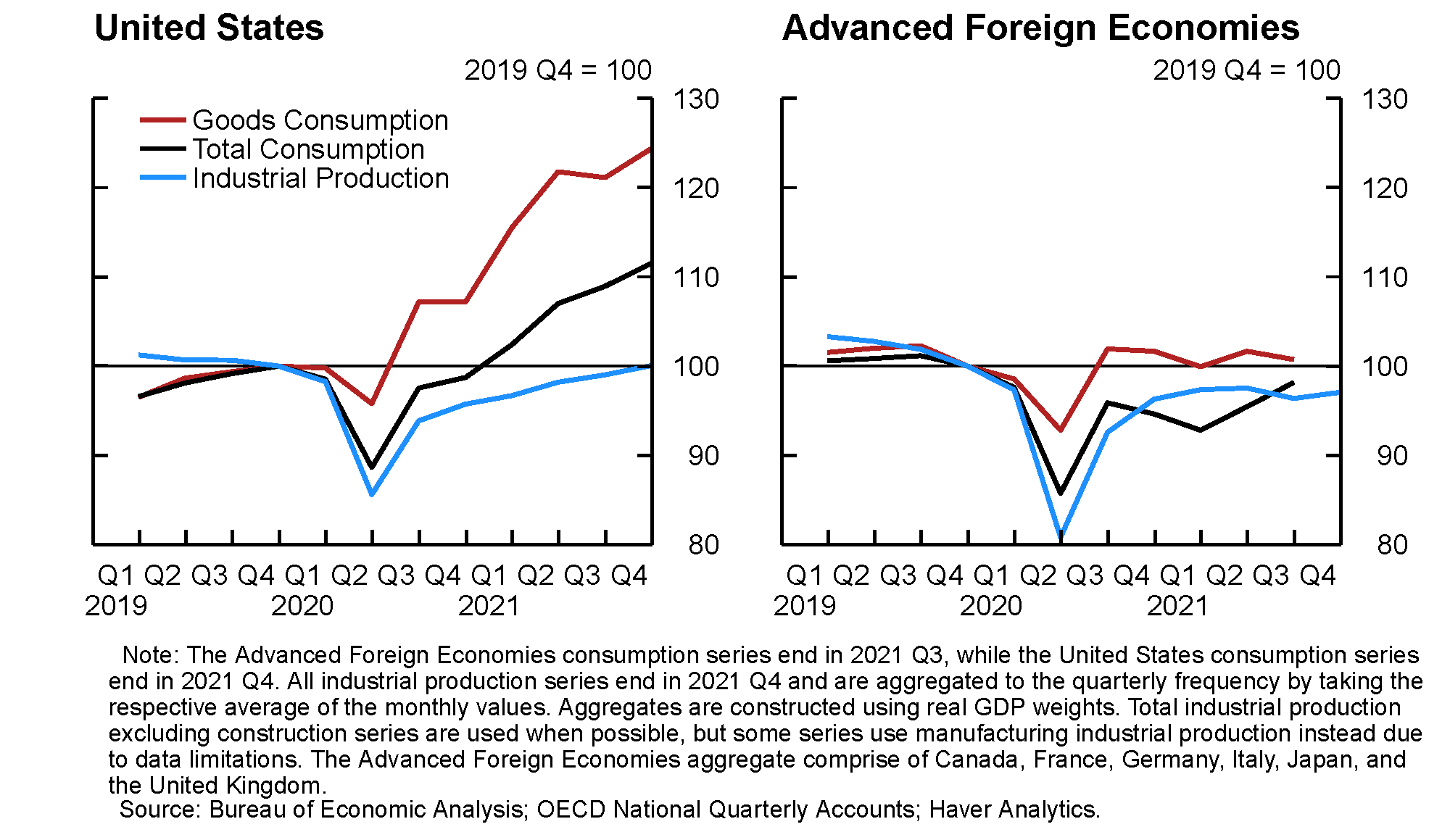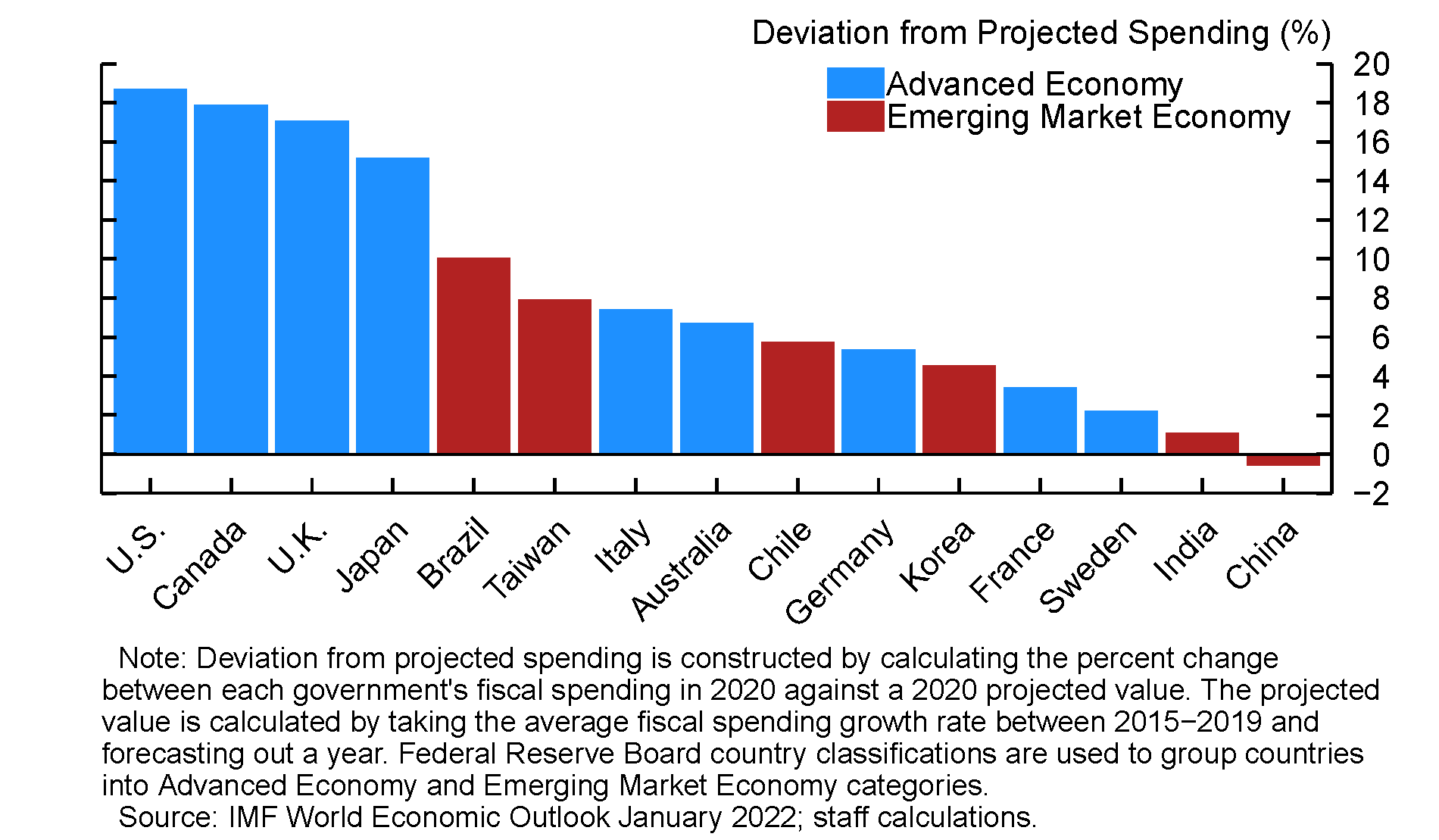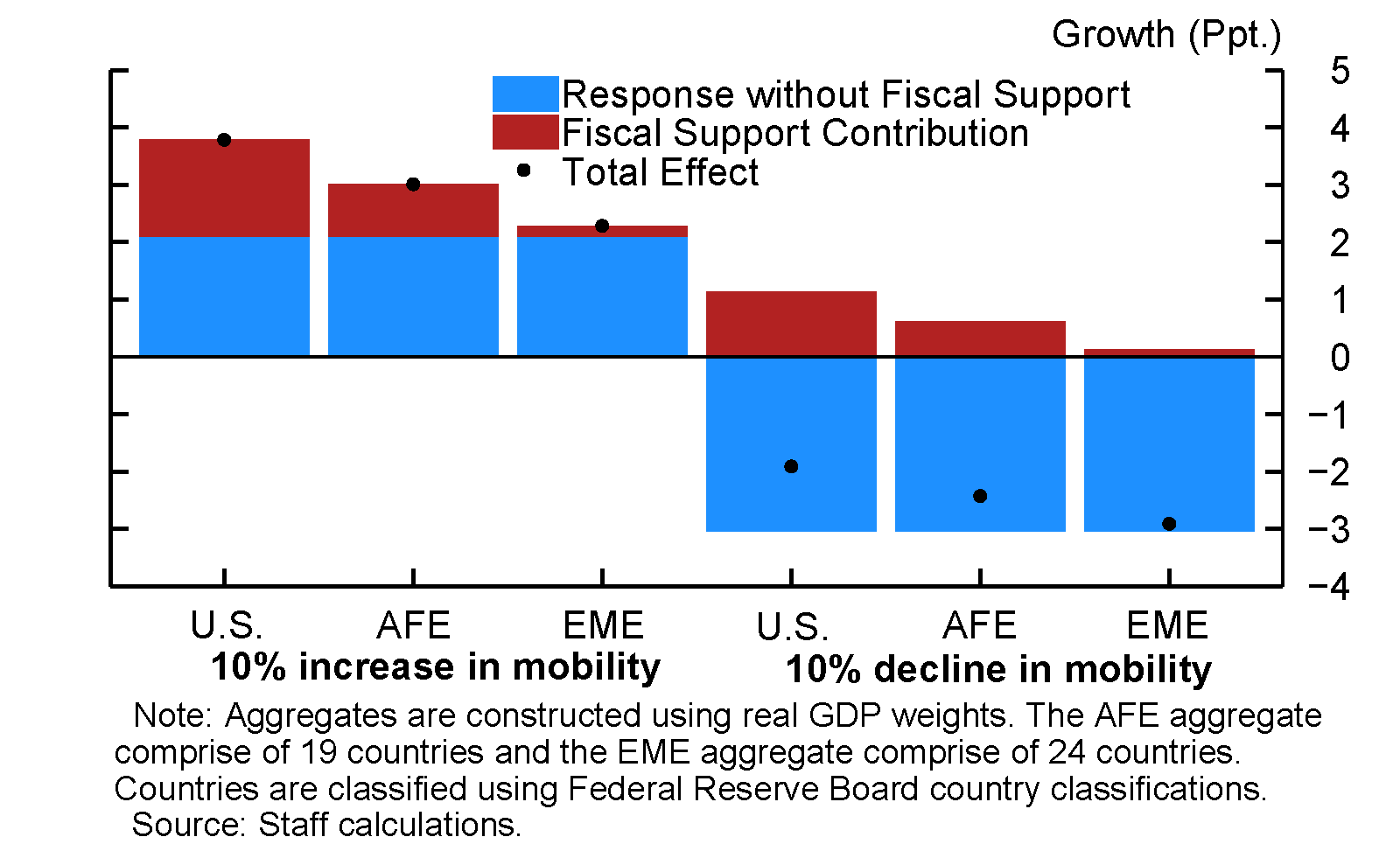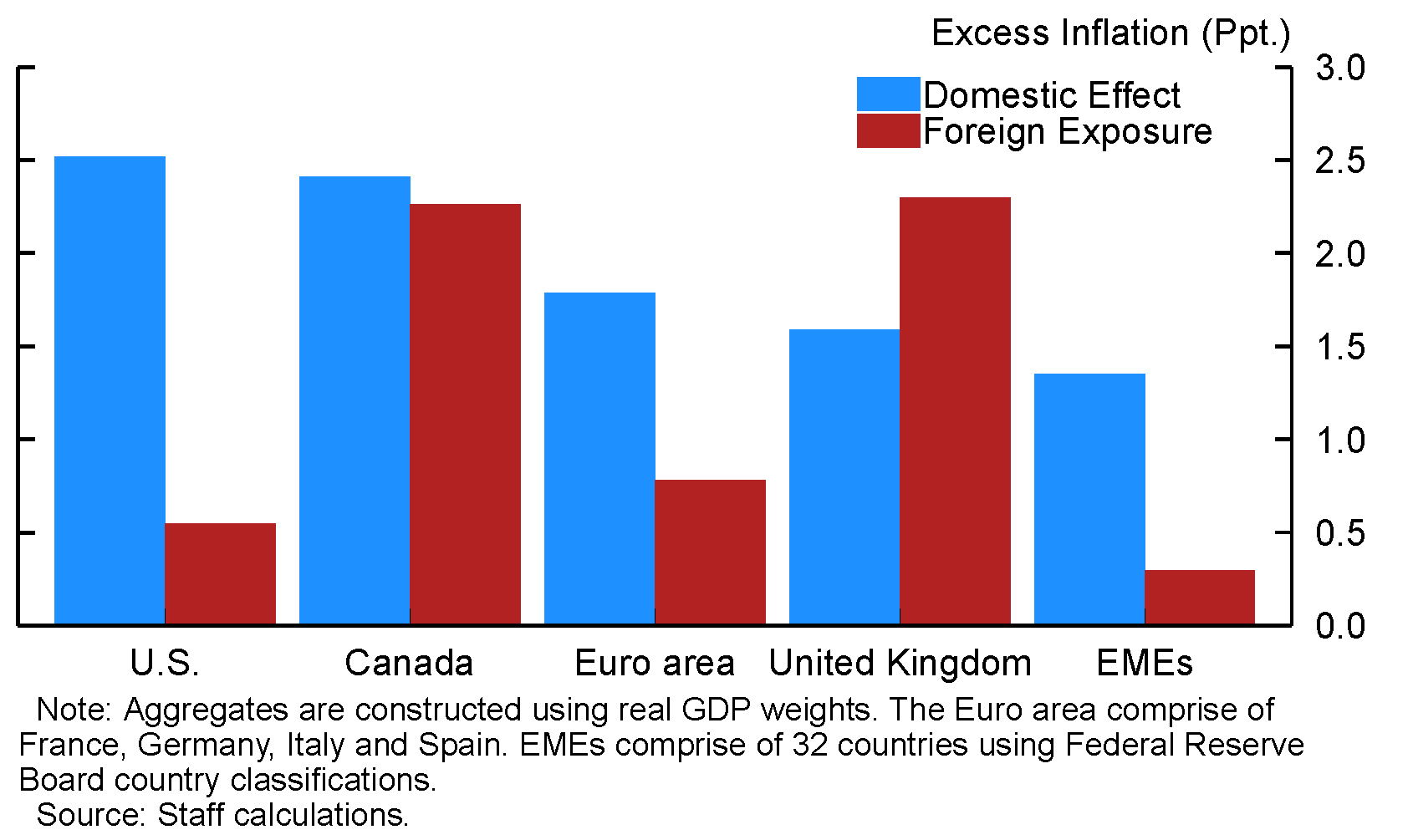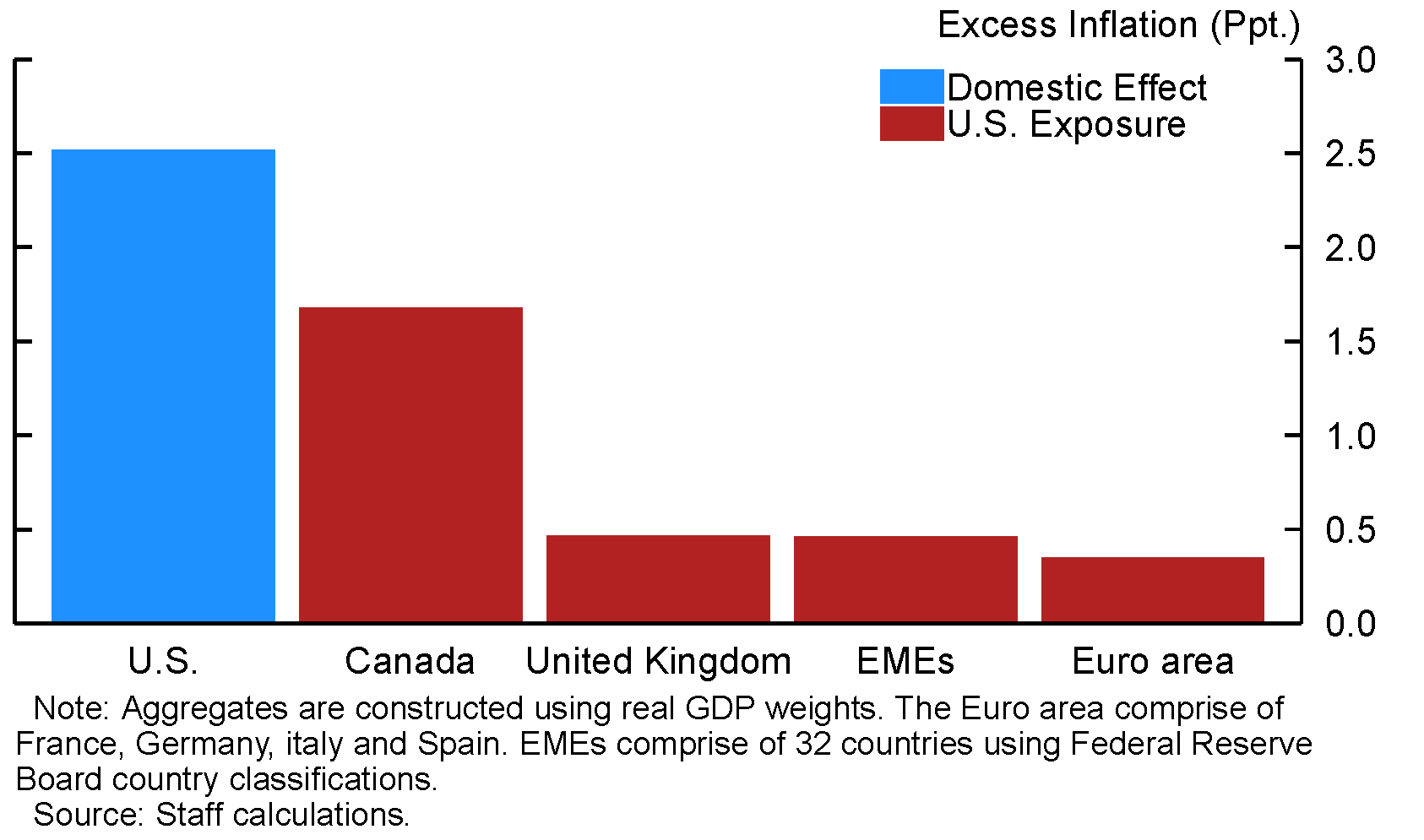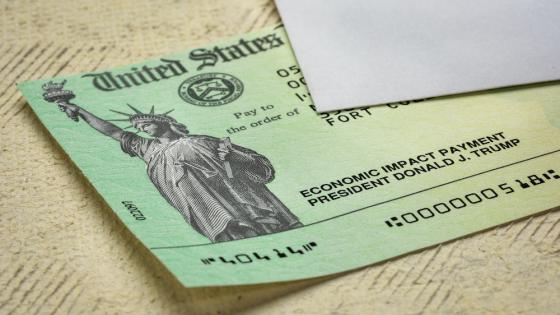In 1970, Milton Friedman famously said, "Inflation is always and everywhere a monetary phenomenon in the sense that it is and can be produced only by a more rapid increase in the quantity of money than in output". A few years later, Sargent and Wallace's 1981 paper "Unpleasant Monetarist Arithmetic" formalised the role of fiscal policy in generating inflation, arguing that monetary and fiscal policy are not completely independent. The recent surge in inflation in many countries around the world has renewed interest in analysing the potential role of large fiscal spending as a driver of price increases.
In our new research (de Soyres et al. 2022), we examine how fiscal support impacted the balance between supply and demand across countries during the COVID-19 crisis. Our findings suggest that fiscal stimulus boosted the consumption of goods without any noticeable impact on production, widening the gap between demand and supply in the goods market.1 As a result, fiscal support contributed to price tensions. A back-of-the-envelope calculation suggests that US fiscal stimulus during the pandemic contributed to an increase in inflation of about 2.5 percentage points in the US, 1.5 percentage points in Canada, and 0.5 percentage points in the UK.
The COVID crisis and fiscal reactions around the world
The COVID-19 pandemic gave rise to unprecedented economic conditions. Due to a mix of government-imposed restrictions and individual decisions, mobility levels collapsed in March 2020, as measured by Google's geo-location tracking data from smartphones. Since then, mobility improved and tracked closely the successive waves of the pandemic (see Figure 1).
Figure 1 Mobility
The pandemic impacted both the supply and demand sides of the economy, hampering firms' ability to produce as well as consumers' ability to consume. On the supply side, government-imposed mobility restrictions and personal decisions from workers resulted in a dramatic decrease in the volume of production. On the demand side, public health restrictions and high uncertainty from both economic and health conditions contributed to a large decrease in total real consumption in the early part of the pandemic. Unlike previous recessions, the consumption of goods and services behaved very differently (see Figure 2). In advanced economies, where real consumption can be split between goods and services, consumption of services fell dramatically and then started recovering slowly as containment policies eased and vaccines were made widely available (Santacreu and LaBelle 2022). In contrast, goods consumption fell by less during the beginning of the pandemic and experienced a strong recovery after that. Industrial production, however, was slow to adjust, creating a discrepancy between supply and demand in the goods markets that likely played a role in the depletion of inventories and ultimately in recent price tensions.2
Figure 2 Real consumption and industrial production during the pandemic
To mitigate the health and economic fallout of the pandemic, many governments engaged in massive fiscal support programmes. Using IMF data, we define each country's total fiscal stimulus as the percentage change in cumulative spending above the country-specific pre-pandemic trend. As shown in Figure 3, the extent of fiscal support is large and heterogeneous across countries.
Figure 3 Estimated pandemic fiscal support for selected countries
Fiscal support, consumption, and production during the periods of recovery
While the pandemic and associated public health restrictions were the main drivers of economic fluctuations over the past two years, fiscal stimulus policies might have shaped the response of consumption and production to changes in mobility. Here, we investigate the association between the size of total fiscal stimulus and the path of consumption and industrial production during the COVID-19 pandemic by evaluating: (i) the elasticity of demand and supply to lockdowns, and (ii) the impact of fiscal stimulus on this elasticity.
Empirical setup
Our empirical strategy consists of projecting quarterly real consumption and production growth on the growth rate of mobility in the same quarter. We also interact these variables with time-invariant country-specific measures of fiscal stimulus. Our objective is to analyze how fiscal support affected country-level consumption and production in response to mobility fluctuations.3
Baseline results
We find that governments that provided generous fiscal support mitigated the drop in goods consumption in periods of lockdowns, while boosting consumption in periods of increased mobility. The effect of fiscal stimulus on services consumption, however, is insignificant. Finally, our results reveal that generous fiscal spending did not significantly contribute to supply expansion: countries with larger fiscal support did not have a significantly different association between mobility and industrial production. In other words, supply did not adjust quickly enough to meet the sharp increase in demand for goods.
Using our point estimates and country-specific values of fiscal support, Figure 4 quantifies the role of fiscal support in shaping the response of goods consumption to fluctuations in mobility. The US is the most impacted country, with consumption decreasing significantly less when mobility drops and rebounding significantly more when mobility increases.
Figure 4 Percentage change in the growth rate of goods consumption in response to mobility changes
Fiscal support and inflation
The previous section highlights that fiscal support boosted goods consumption without any noticeable impact on the supply of goods. Hence, the large increase in demand triggered by the fiscal stimulus policy, together with the slow pace of adjustment in production, likely contributed to the current imbalance in the goods market, resulting in the depletion of inventories, pronounced bottlenecks, and ultimately inflation.
The steep surge in goods consumption in countries with large fiscal support may have also created extra demand in other countries through trade linkages. This demand surge was met by limited supply capacity. Indeed, while production, transportation, and shipping capacity have adapted to increasing global value chain participation over the past few decades, the necessary infrastructure appeared to be quite inelastic in the short run.4 To further investigate this intuition, we turn to a cross-country regression analysis. For each country, we compute ‘excess inflation’ by taking the 2021Q4 12-months inflation rate and subtracting the average inflation rate each country experienced during the 2015-2019 period. We then construct several measures of exposure to domestic and foreign fiscal stimulus and project excess inflation on such measures.5
First, Exposure to Domestic Fiscal Stimulus captures each country's total fiscal spending over the pre-pandemic average. Second, Exposure to Foreign Fiscal Stimulus measures a country's exposure to foreign stimuli and contains two parts: (i) a 'vertical' component which is defined as a trade-weighted average of other countries' stimulus measures, and (ii) a 'horizontal' component capturing the exposure of each country's import-partners to third countries' fiscal stimulus. Intuitively, the US can be exposed to the fiscal stimulus from Canada, both through a high import share (i.e. imported inflation) and through a high export share (i.e. higher demand from Canada). This captures vertical foreign exposure. Moreover, the price of Canada's exports to the US may be pushed up by Canada's exposure to Mexico's fiscal stimulus. This captures horizontal foreign exposure.
We find that excess inflation is significantly correlated with each country's domestic stimulus, as well as with exposure to the foreign stimulus. When taken separately or when used in conjunction with domestic fiscal stimulus, both vertical and horizontal exposures to foreign stimulus appear to be significantly correlated with domestic excess inflation. Moreover, our results show that excess inflation is also strongly related to our aggregated measure of Foreign Exposure.
Back-of-the-envelope calculation: Quantifying the impact of fiscal stimulus on inflation
Based on our estimates, Figure 5a presents the impact of domestic and foreign exposure on excess inflation for several regions. The impact of domestic fiscal stimulus on inflation is highest in the US. Canada, a country with strong trade links with the US, features a high level of excess inflation related to exposure to foreign fiscal stimulus. In small open economies, such as Canada and the UK, foreign exposure has a relatively stronger effect on inflation than large economies like the US or the euro area.
In Figure 5b, we derive a measure of 'international spillover' of US fiscal stimulus. In particular, we isolate the share of US stimulus in foreign exposure for several countries and compute the associated excess inflation in those countries. Our estimation implies that US fiscal stimulus was associated with excess inflation of about 1.5 percentage points in Canada and 0.5 percentage points in the UK.
Figure 5 Fiscal stimulus and excess inflation
a) Impact of domestic and foreign fiscal stimulus on inflation in selected countries
b) Impact of US fiscal stimulus on inflation in the US and abroad
Conclusion
As widely noted, the COVID-19 pandemic gave rise to a very peculiar economic shock, affecting both firms' ability to produce and consumers' ability to consume. In response to this shock, most governments in advanced economies injected large amounts of money into the economy. This policy was successful at boosting consumption which, together with relatively inelastic supply, may have led to supply chain bottlenecks and price tensions. Our analysis suggests a sizable role of fiscal policy in affecting price stability, over and beyond what a monetary authority can do. This is reminiscent of Sargent and Wallace's “unpleasant monetarist arithmetic".6
However, one should also recognise the positive role played by generous government support throughout this unprecedented crisis. Overall, large spending also favoured a strong economic rebound, with both GDP and employment recovering at a remarkable pace. Without a clear counterfactual exercise, one can only speculate what the economic path would have been without such government spending. However, it seems appropriate to consider its role in generating supply-demand imbalances in a moment in which there have been constraints in production, capacity, and shipping.
Authors' note: The views expressed in this column are our own, and do not represent the views of the Board of Governors of the Federal Reserve, the Federal Reserve Bank of Saint Louis, nor any other person associated with the Federal Reserve System.
References
Amiti, M, S Heise and A Wang (2021), "High Import Prices along the Global Supply Chain Feed Through to US Domestic Prices.", Federal Reserve Bank of New York Liberty Street Economics, 8 November.
Baldwin, R and R Freeman (2021), “Risks and global supply chains: What we know and what we need to know”, NBER Working Paper No. w29444.
Ball, L, G Gopinath, D Leig, P Mitra, and A Spilimbergo (2021), "US Inflation: Set for Take-off?", VoxEU.org, 07 May.
Brignone, D, A Dieppe, and M Ricci (2021), "Quantifying the risks of persistently higher US inflation", VoxEU.org, 01 November.
de Soyres, F, A M Santacreu and H Young (2022), “Demand-Supply imbalance during the Covid-19 pandemic: the role of fiscal policy”.
Forbes, K, J Gagnon, C Collins (2021), "Pandemic inflation and nonlinear, global Phillips curves", VoxEU.org, 21 December.
Leibovici, F and J Dunn (2021), "Supply Chain Bottlenecks and Inflation: The Role of Semiconductors", Federal Reserve Bank of St. Louis Economic Synopses No. 28.
Santacreu, AM and J LaBelle (2022), "Supply Chain Disruptions During the COVID-19 Recession", Economic Synopses No. 2.
Santacreu, A M, F Leibovici and L Jesse (2021), "Global Value Chains and US Economic Activity During COVID-19", Federal Reserve Bank of St. Louis Review 103(3): 271-88.
Santacreu, A M and J LaBelle (2021a), "Rethinking Global Value Chains During COVID-19: Part 1", Federal Reserve Bank of St. Louis Economic Synopses No. 16.
Santacreu, A M and J LaBelle (2021b), "Rethinking Global Value Chains During COVID-19: Part 2", Federal Reserve Bank of St. Louis Economic Synopses No. 17.
Santacreu, A M and J LaBelle (2022), "Global Supply Chain Disruptions and Inflation During the COVID-19 Pandemic", Federal Reserve Bank of St. Louis Review, forthcoming.
Sargent, T J and N Wallace (1981), "Some Unpleasant Monetarist Arithmetic", Federal Reserve Bank of Minneapolis Quarterly Review, Fall 1981: 1-15.
Sims, C A (2011), "Stepping on a Rake: The Role of Fiscal Policy in the Inflation of the 1970s", European Economic Review 55(1): 48-56.
Kehoe, T and J P Nicolini (eds), (2021), Monetary and Fiscal History of Latin America, 1960-2017, University of Minnesota Press.
Endnotes
1 Brignone et al. (2021) show a moderate increase in US CPI inflation from fiscal stimulus policies. In contrast, Ball et al. (2021) document that, at least in advanced economies, the temporary nature of price pressures, well-anchored inflation expectations, and structural factors are still depressing inflation.
2 Several aspects of this line of reasoning, including the role of semiconductors and the importance of supply-chain bottlenecks, have been documented in recent contributions such as Amiti et al. (2021), Leibovici and Dunn (2021), Santacreu et al. (2021), Santacreu and LaBelle (2021a, 2021b, 2022).
3 In our baseline specifications, we use country fixed effects to account for unobservable factors such as heterogeneous trend growth across countries. Our results are qualitatively similar with different fixed effects.
4 See Baldwin and Freeman (2021) for a discussion on how global supply chain disruptions surged during the COVID-19 pandemic.
5 Forbes et al. (2021) document that global factors and nonlinearities in the Phillips curve played a key role in driving inflation rates during the pandemic.
6 In a recent book, Kehoe and Nicolini (2021) also argue that many countries in Latin America have been experiencing this link between fiscal spending and inflation over the past six decades. Their lesson is that good economic policy is a combination of good fiscal policy and good monetary policy.
